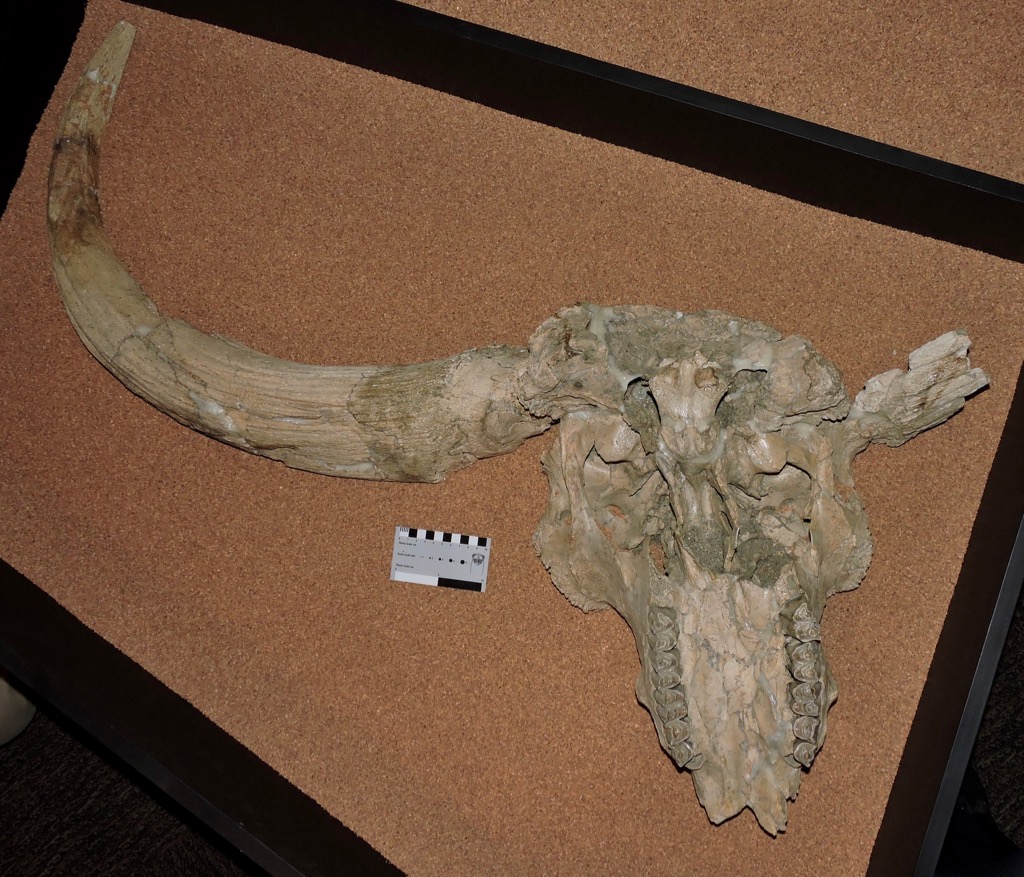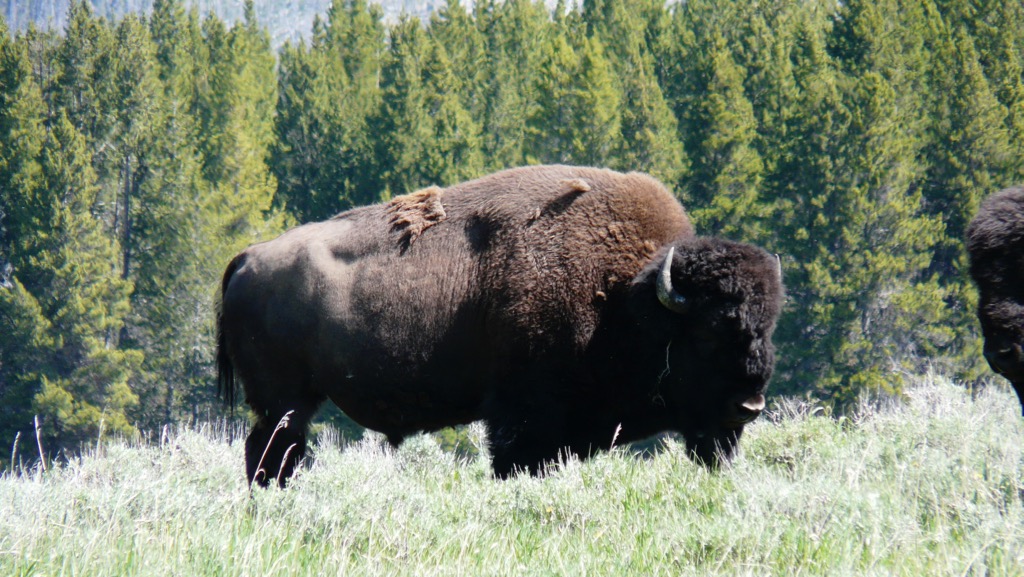 We still have a few days left in our crowdfunding campaign to study mastodons, but for Fossil Friday this week I'm stepping away from mastodons to look at a different animal. Earlier this week the U. S. Government passed a law designating the American bison (Bison bison) as the United States' National Mammal. Bison are prominent in the fossil record, including at Diamond Valley Lake.As I've mentioned in previous posts, there were two species of bison present at Diamond Valley Lake. The more common species was Bison antiquus, a possible direct ancestor to the modern B. bison. The rarer, larger species was the long-horned bison, B. latifrons.Diamond Valley Lake's best B. latifrons skull, shown above, is on permanent exhibit at the museum. It's displayed in ventral view, and in the image the front of the skull is at the bottom. The premaxillae forming the tip of the upper jaws is missing, as is the right horn core, but otherwise the skull is mostly complete if a bit deformed. One thing to keep in mind when looking at fossils of Bison latifrons (and, indeed, any fossil bovid) is that the preserved horn is simply the bone core of the horn. In life the core is covered with a keratin sheath, making the living horn considerably larger.It's somehow fitting that the United States' national mammal is in fact an immigrant to North America, and a relatively recent one at that. Bison were one of the last large mammals from the old world to spread across North America (some of the other large Old World immigrants, such as deer, mammoths, and mastodons, and South American ground sloths, all arrived earlier). In fact, bison only made it south of the 55th parallel (which runs through central Canada) roughly 250,000 years ago, and then rapidly spread across southern Canada and the United States. The first appearance of bison south of the 55th parallel is used by paleontologists at the marker for the start of the Rancholabrean North American Land Mammal Age (NALMA), the last NALMA of the Ice Age.During the Rancholabrean, various bison species ranged across the entire northern hemisphere. While some bison species went extinct at the end of the Ice Age, the genus Bison survived and thrived in the Holocene in both Eurasia and especially in North America. Two extant species are recognized, the American bison (Bison bison) (seen at Yellowstone National Park) and the European bison (Bison bonasus) (seen at the San Diego Zoo Safari Park):
We still have a few days left in our crowdfunding campaign to study mastodons, but for Fossil Friday this week I'm stepping away from mastodons to look at a different animal. Earlier this week the U. S. Government passed a law designating the American bison (Bison bison) as the United States' National Mammal. Bison are prominent in the fossil record, including at Diamond Valley Lake.As I've mentioned in previous posts, there were two species of bison present at Diamond Valley Lake. The more common species was Bison antiquus, a possible direct ancestor to the modern B. bison. The rarer, larger species was the long-horned bison, B. latifrons.Diamond Valley Lake's best B. latifrons skull, shown above, is on permanent exhibit at the museum. It's displayed in ventral view, and in the image the front of the skull is at the bottom. The premaxillae forming the tip of the upper jaws is missing, as is the right horn core, but otherwise the skull is mostly complete if a bit deformed. One thing to keep in mind when looking at fossils of Bison latifrons (and, indeed, any fossil bovid) is that the preserved horn is simply the bone core of the horn. In life the core is covered with a keratin sheath, making the living horn considerably larger.It's somehow fitting that the United States' national mammal is in fact an immigrant to North America, and a relatively recent one at that. Bison were one of the last large mammals from the old world to spread across North America (some of the other large Old World immigrants, such as deer, mammoths, and mastodons, and South American ground sloths, all arrived earlier). In fact, bison only made it south of the 55th parallel (which runs through central Canada) roughly 250,000 years ago, and then rapidly spread across southern Canada and the United States. The first appearance of bison south of the 55th parallel is used by paleontologists at the marker for the start of the Rancholabrean North American Land Mammal Age (NALMA), the last NALMA of the Ice Age.During the Rancholabrean, various bison species ranged across the entire northern hemisphere. While some bison species went extinct at the end of the Ice Age, the genus Bison survived and thrived in the Holocene in both Eurasia and especially in North America. Two extant species are recognized, the American bison (Bison bison) (seen at Yellowstone National Park) and the European bison (Bison bonasus) (seen at the San Diego Zoo Safari Park):
 This wasn't to last, as bison were almost completely wiped out by overhunting and habitat loss over the last few hundred years. Both species have been protected and are slowly recovering, although populations were reduced to such a low number in the past that genetic diversity is quite low. Even so, there are once again wild herds of both species living in protected areas.
This wasn't to last, as bison were almost completely wiped out by overhunting and habitat loss over the last few hundred years. Both species have been protected and are slowly recovering, although populations were reduced to such a low number in the past that genetic diversity is quite low. Even so, there are once again wild herds of both species living in protected areas.
